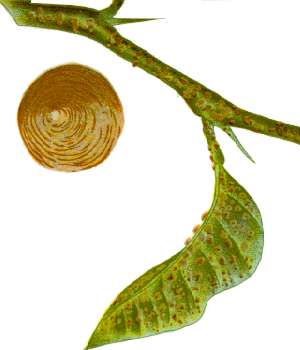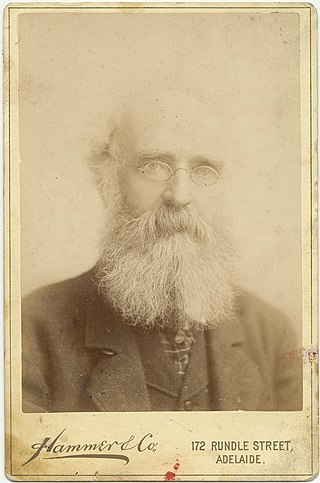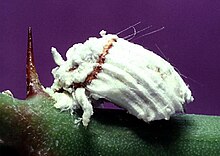
Scale insects are small insects of the order Hemiptera, suborder Sternorrhyncha. Of dramatically variable appearance and extreme sexual dimorphism, they comprise the infraorder Coccomorpha which is considered a more convenient grouping than the superfamily Coccoidea due to taxonomic uncertainties. Adult females typically have soft bodies and no limbs, and are concealed underneath domed scales, extruding quantities of wax for protection. Some species are hermaphroditic, with a combined ovotestis instead of separate ovaries and testes. Males, in the species where they occur, have legs and sometimes wings, and resemble small flies. Scale insects are herbivores, piercing plant tissues with their mouthparts and remaining in one place, feeding on sap. The excess fluid they imbibe is secreted as honeydew on which sooty mold tends to grow. The insects often have a mutualistic relationship with ants, which feed on the honeydew and protect them from predators. There are about 8,000 described species.

The Margarodidae or ground pearls are a family of scale insects within the superfamily Coccoidea. Members of the family include the Polish cochineal and Armenian cochineal and the original ground pearl genus, Margarodes. Beginning in 1880, a number of distinct subfamilies were recognized, with the giant coccids being the first. Although Maskell proposed a new family, many continued to regard the monophlebids as a mere subfamily for many years, and the Margarodidae classification continued to be polyphyletic through the 20th Century. Since then, taking the advice of Koteja several subfamilies and tribes have been elevated into their own families such as Matsucoccidae and Xylococcidae. The pared-down family of Margarodidae is monophyletic.

Icerya purchasi is a scale insect that feeds on more than 80 families of woody plants, most notably on Citrus and Pittosporum. Originally described in 1878 from specimens collected in New Zealand as pests of kangaroo acacia and named by W.M. Maskell "after the Rev. Dr. Purchas who, [he] believe[d], first found it", it is now found worldwide where citrus crops are grown. The cottony cushion scale originates from Australia.

Aspidiotus is a genus of armoured scale insects. It includes several agricultural and horticultural pests.

Albert Koebele was an economic entomologist and a pioneer in the use of biological controls to manage insect pests.

Novius cardinalis is a species of ladybird beetle native to Australia. It was formerly placed in the genus Rodolia, but that genus was synonymized under the genus Novius in 2020.

Coccus is a genus of scale insects in the family Coccidae. Several species, such as Coccus viridis, a major pest of coffee, are major agricultural pests. The type species is Coccus hesperidumLinnaeus.

Monophlebidae is a family of scale insects commonly known as the giant scales or monophlebids. They occur in most parts of the world but more genera are found in the tropics than elsewhere.
Chionaspis is a genus of scale insect. In 2011 geographical sampling and analysis indicated a number of unnamed species in the genus Chionaspis.

Frazer Smith Crawford was a photographer in the colony of South Australia, founding manager of the Adelaide Photographic Company, then photolithographer for the Government of South Australia. In a seemingly unrelated sphere, Crawford came to be recognised as an authority on agricultural pests and diseases, particularly known for identifying and exploiting naturally occurring predators of plant pests.

Pseudaulacaspis is a genus of scales and mealybugs in the family Diaspididae. There are at least 60 described species in Pseudaulacaspis.
Hemiberlesia is a genus of scales and mealybugs in the family Diaspididae. There are at least 30 described species in Hemiberlesia.

Parlatoria is a genus of scales and mealybugs in the family Diaspididae. There are at least 60 described species in Parlatoria.
Diaspis is a genus of scales and mealybugs in the family Diaspididae. There are at least 50 described species in Diaspis.

Arthur Guyon Purchas was a clergyman, missionary, surgeon, musician, engineer, inventor, pioneer, geologist and botanist born at St. Arvans in the Wye Valley, Monmouthshire, Wales, who lived most of his life in Auckland, New Zealand. He was the father of fourteen children and an important figure during British colonisation of New Zealand, described as an 'amazingly versatile colonist'.

Antecerococcus is a genus of scale insects. They are found worldwide but with greater abundance in the Old World. There are about 56 species:













